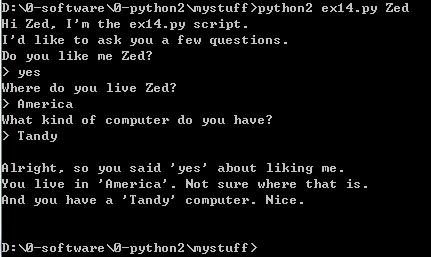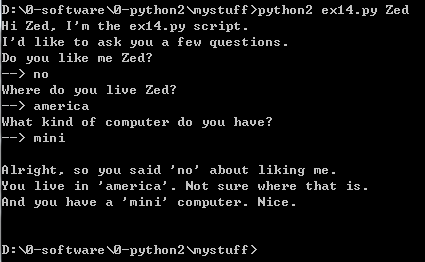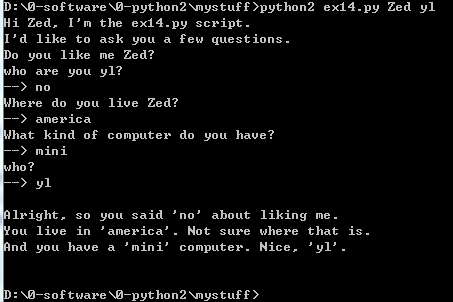笨办法学Python(十四)
习题 14:提示和传递
让我们使用 argv 和 raw_input 一起来向用户提一些特别的问题。下一节习题你会学习如何读写文件,这节练习是下节的基础。在这道习题里我们将用略微不同的方法使用 raw_input,让它打出一个简单的 > 作为提示符。这和一些游戏中的方式类似,例如 Zork 或者 Adventure 这两款游戏。

1 from sys import argv 2 3 script, user_name = argv 4 prompt = '> ' 5 6 print "Hi %s, I'm the %s script." % (user_name, script) 7 print "I'd like to ask you a few questions." 8 print "Do you like me %s?" % user_name 9 likes = raw_input(prompt) 10 11 print "Where do you live %s?" % user_name 12 lives = raw_input(prompt) 13 14 print "What kind of computer do you have?" 15 computer = raw_input(prompt) 16 17 print """ 18 Alright, so you said %r about liking me. 19 You live in %r. Not sure where that is. 20 And you have a %r computer. Nice. 21 """ % (likes, lives, computer)
我们将用户提示符设置为变量 prompt,这样我们就不需要在每次用到 raw_input 时重复输入提示用户的字符了。而且如果你要将提示符修改成别的字串,你只要改一个位置就可以了。
非常顺手吧。
你应该看到的结果
当你运行这个脚本时,记住你需要把你的名字赋给这个脚本,让 argv 参数接收到你的名称。

加分习题
1. 查一下 Zork 和 Adventure 是两个怎样的游戏。 看看能不能下载到一版,然后玩玩看。
2. 将 prompt 变量改成完全不同的内容再运行一遍。
3. 给你的脚本再添加一个参数,让你的程序用到这个参数。
4. 确认你弄懂了三个引号 """ 可以定义多行字符串,而 % 是字符串的格式化工具。
习题练习
2.

3.

1 from sys import argv 2 3 script, user_name, who = argv 4 prompt = '--> ' 5 6 print "Hi %s, I'm the %s script." % (user_name, script) 7 print "I'd like to ask you a few questions." 8 print "Do you like me %s?" % user_name 9 print "who are you %s?" % who 10 likes = raw_input(prompt) 11 12 print "Where do you live %s?" % user_name 13 lives = raw_input(prompt) 14 15 print "What kind of computer do you have?" 16 computer = raw_input(prompt) 17 18 print "who?" 19 name = raw_input(prompt) 20 21 print """ 22 Alright, so you said %r about liking me. 23 You live in %r. Not sure where that is. 24 And you have a %r computer. Nice, %r. 25 """ % (likes, lives, computer, who)







